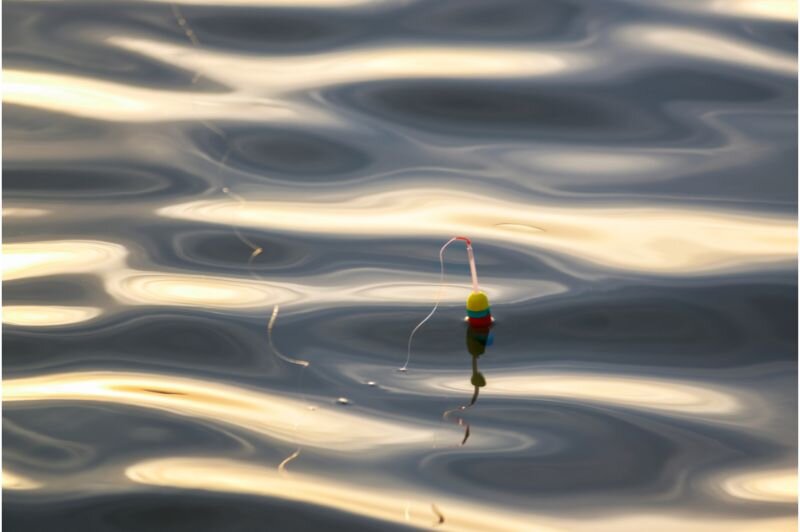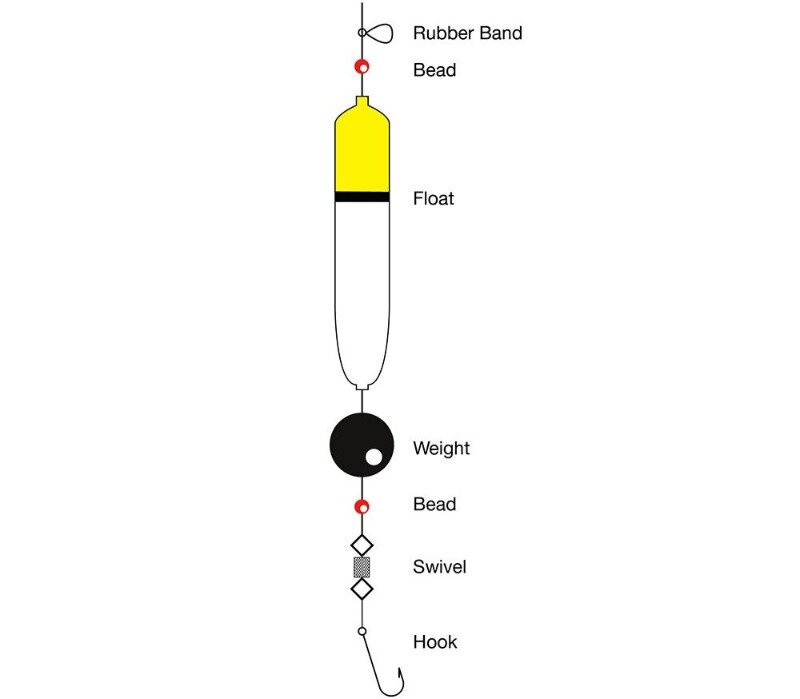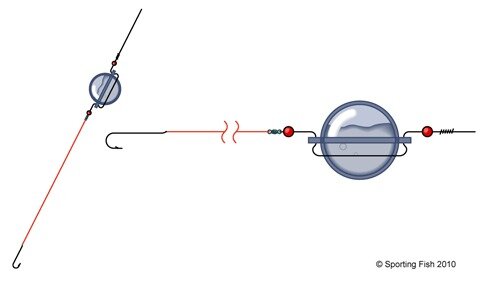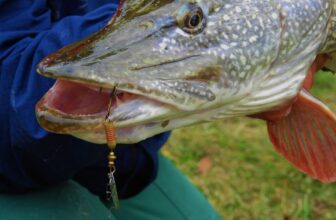Float fishing for bass is an established method of fishing for these powerful predators and has been known to catch the biggest bass. Whilst float fishing seems like an unusually sedate form of fishing for bass, it is a particularly effective method in murky conditions when visibility is low or when conditions are too calm and fish spook easily.
You can find out more in our beginner’s guide to bass fishing in the UK.

You don’t cover as much ground when lure fishing for bass and you won’t see the same spectacular scenery. But you do stand a chance of catching some spectacular bass in conditions otherwise unsuited to lure fishing.
Table of contents
Can you float fish for bass?
Yes you can float fish for sea bass in the UK. Rather counter-intuitively you can float fish for many different saltwater species of fish including bass, pollock, mullet, mackerel, garfish and wrasse to name but a few. Float fishing with bait (particularly at night) is an established method known to target the biggest bass. These big bass are tough to find with lures as they tend to live quite a solo existence.
What do I need to float fish for bass?
In order to float fish for bass, you will need:
- A rod: A nine-foot + rod is essential. Generally, if casting from the beach, the larger the rod the further you can cast. Look for rods with a casting weight of 60g to account for the weight and bait.
- A reel: simple fixed spools or spinning reels work absolutely fine
- Line: braid with a breaking strain of 15lbs plus
- Leader: whilst not essential as it is when lure fishing for bass, a fluorocarbon leader with a breaking strain similar to your main line will prevent any break-offs
- Weight(s): generally weights of around 2oz should be enough to set the float you’re using to fish for bass
- A float: larger tubular floats are commonly used, as are bubble floats. Bubble floats allow for a greater casting distance (as they’re partially filled with water) and visibility. They’re more commonly used with live bait fishing.
- A hook: a common misnomer is the bigger the hook the bigger the fish. Your hook should be appropriate to the type of bait you’re using, not necessarily the size of fish you’re targeting
- Swivels and beads: to protect against knots and to create a stopping point for the float
- Bait: shrimp, peeler crabs, lugworms, squid or mackerel
Top 7 tips for float fishing for bass in the UK
It’s also worth checking out our more generic top tips for bass fishing article. But here are some float fishing-specific tips.
1. Avoid high winds
Float fishing in high winds and rough conditions makes float fishing in the sea spectacularly challenging. Casting and identifying take becomes extremely difficult, even with aggressive strikes from bass.
2. Look for deeper water
Float fishing requires deeper water than lure or bait fishing. When lure fishing for bass you can target the surface with poppers or topwater lures and bait tends to naturally sit on the bottom. Whereas float fishing suspends the bait from the surface and requires depth. So look for sudden dropoffs or areas of deep water around structure like piers or jetties.
3. Fish the flooded tide
Bass fishing is governed by the tide at the best of times (two hours either side of high and low tide is a good starting point) and float fishing for bass is no exception. But as bass are prone to hunting over rocky ground and structure, the flooded tide makes fishing in close with a float much easier.

4. Use a sizeable float
If you’re used to float fishing small, calm freshwaters like carp lakes or certain stretches of river, saltwater float fishing is a whole different kettle of fish. Rougher, whitewater-ridden waves can make spying on your float tricky. So bigger, brighter floats are good starting points.
5. Wait until the float is fully submerged before striking
When float fishing for bass specifically it’s best to wait until the float fish is fully submerged. Other species like garfish don’t strike as aggressively and the float may bob along the surface for some time. Whereas when a bass strikes and really takes the bait, your float will go under. So stay patient. Particularly as the wind and waves can play havoc with your float on the surface.
6. Groundbaiting… If you can
You probably only think of groundbaiting when fishing in smaller freshwaters, but it can be equally effective in the sea too. As the sea is an unforgiving mistress using something particularly pungent is your best bet. So oily fish like mackerel is an excellent choice. An excellent tip is to use the guts of these oily fish for maximum stink, without wasting actual bait.
7. Always use a hook length with a weaker breaking strain than your mainline
They say save the best until last and this tip is the creme-de-la-creme. If you use a hook length with the same breaking strain as your mainline, you’re just as likely to break off your entire rig than just the hook length. As an example, if you’re using 15lb mainline, use a 12lb line for your hook length. This will save literally hours of re-rigging time.
What is the best bait for bass float fishing?
If you’re float fishing for bass, the best baits are prawns, mackerel, lugworms, squid and peeler crab (crab without its shell). But the best bait for float fishing for bass depends on the mark you’re fishing, the time of year and the conditions.

Murkier water tends to fish better with pungent baits like mackerel. Whereas crystal clear water can be fished with just about anything – as long as the water is choppy. Crabs start to peel their shells in the spring, meaning the warmer summer months are full of peeler crabs and an ideal time to use them as bait. In the autumn, the crabs stop peeling and become less appetising prospect for bait.
What’s the best rig for float fishing for bass?
When float fishing for bass a standard float fishing setup will do. One that has a stop knot, a float and weight sandwiched between two beads so you can slide the float up or down to change the depth easily, followed by a swivel and a hook attached to the mainline. This can be a braided line as per your mainline or a fluorocarbon leader if the area you’re fishing is snaggy or the conditions are rough.

What is a bubble float rig?
A bubble float rig is a simple float fishing setup that has a typical hook length at one end and a water-filled, typically clear plastic ‘bubble’ at the other. The bubble float rig is designed to help you cast further than a traditional float rig, making it invaluable for fishing larger waters.

Is a bubble rig a good setup for bass fishing?
Using a bubble rig can be a very effective method for float fishing with bass. The bubble itself is a 3-inch wide object that can be filled with water and used much like a float. The benefit it has over traditional floats is the added weight and circumference. So in the sea, you can cast further and see the bubble more effectively than with traditional pencil floats.
Bubble floats are fantastic for beginners (thanks to their ease of setup) and for casting larger distances. The more water you add, the further you can cast. It has an added benefit of being quite incongruous, particularly if you use a see-through bubble. So great for skittish bass.
How do you rig a bubble float for bass?
Setting up a bubble float rig is slightly different to a traditional float fishing setup as a bubble float has holes on either side that you need to pass the mainline through.
- Thread the mainline through one side of the bubble float and then the other
- Tie a figure of a loop knot to attach the hook length to it
- Tie a hook-length section of line with a hook attached to the end
- Attach the hook length to the figure of eight loop section on the mainline
- Fill the bubble float partially with water to aid in casting distance
FAQs
Can you float fish for bass with lures?
No, you shouldn’t float fish for bass with lures. Lure fishing requires a constant cast and retrieve style motion to entice the bass into attacking their prey for either food or to preserve their territory.
Float fishing on the other hand is a patient form of fishing that uses bait, waiting for the bass to eat it. Oily fish like mackerel is an excellent bait for float fishing because it is so pungent.
What rod should I use to float fish for bass in the UK?
When float fishing for bass in the UK your rod should be a minimum of 9-10 foot long with a casting weight of around 20-60g. Unless you’re fishing with bigger baits. A supple-tipped rod with a casting weight suitable to the size and weight of bait you’re using should work perfectly well.
Where should the bait be when float fishing for bass?
By nature bass fish in quite shallow waters and will fish for prey on the surface, but are equally adept at hunting out peeler crabs from the ocean floor. So the best advice when float fishing is to start on or near to the sea floor and get progressively shallower to fish at different depths.
Hi, I'm Harry. A keen, albeit exceedingly average fisherman. I've spent the last few years trawling London's waterways with - if I'm being kind - varied success and would love to help you avoid the mistakes I have made.






